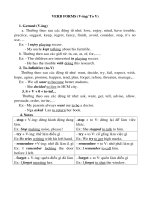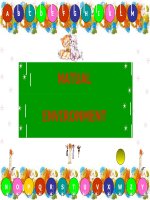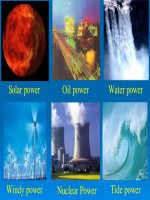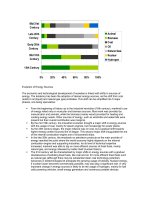- Trang chủ >>
- THPT Quốc Gia >>
- Hóa
Changing energy forms
Bạn đang xem bản rút gọn của tài liệu. Xem và tải ngay bản đầy đủ của tài liệu tại đây (2.9 MB, 10 trang )
Physical Science
by Lillian Duggan
Genre
Nonfiction
Comprehension Skill
Sequence
Text Features
•
•
•
•
Captions
Charts
Diagrams
Glossary
Science Content
Forms of Energy
Scott Foresman Science 6.17
ISBN 0-328-14018-X
ì<(sk$m)=beabid< +^-Ä-U-Ä-U
Vocabulary
What did you learn?
electric circuit
1. What causes an electric charge to move along atoms?
electric current
electric motor
2. What is the difference
series circuit and a parallel
by between
Lilliana Duggan
circuit?
energy
3. How can you make an electromagnet stronger?
generator
Changing Energy Forms
4.
The law of conservation of energy states
that whenever energy changes from one form to another, the total
amount of energy does not change. Explain how this law is related
to a bouncing ball. Include details from the book to support your
answer.
5.
Sequence Describe in order the energy changes that are
involved in drinking a glass of orange juice, starting with the Sun.
kinetic energy
magnetic domain
potential energy
Illustrations: 12–15 Tony Randazzo
Photographs: Every effort has been made to secure permission and provide appropriate credit for
photographic material. The publisher deeply regrets any omission and pledges to correct errors called to its
attention in subsequent editions. Unless otherwise acknowledged, all photographs are the property of Scott
Foresman, a division of Pearson Education. Photo locators denoted as follows: Top (T), Center (C), Bottom
(B), Left (L), Right (R), Background (Bkgd).
2 ©Norbert Wu/Minden Pictures; 3 (TR) ©Rosenfeld Images Ltd./Photo Researchers, Inc., (B) ©Bruce H.
Frisch/Photo Researchers, Inc.; 5 ©Simon Fraser/Photo Researchers, Inc.; 6 (BC) ©Dr. Paul A. Zahl/Photo
Researchers, Inc.; 10 (TR, BL) ©Doug Martin/Photo Researchers, Inc.
ISBN: 0-328-14018-X
Copyright © Pearson Education, Inc.
All Rights Reserved. Printed in the United States of America. This publication is
protected by Copyright and permission should be obtained from the publisher prior
to any prohibited reproduction, storage in a retrieval system, or transmission in any
form by any means, electronic, mechanical, photocopying, recording, or likewise. For
information regarding permissions, write to: Permissions Department, Scott Foresman,
1900 East Lake Avenue, Glenview, Illinois 60025.
2 3 4 5 6 7 8 9 10 V010 13 12 11 10 09 08 07 06 05
How can energy change?
Forms of Energy
Every change, from cutting an apple to
flipping a switch, involves energy. This is
because energy is needed to do work. For
this reason, energy and work are both
measured in the same unit, the joule.
When you do work on an object, you
transfer energy from yourself to the object.
Energy is the ability to cause change or
to do work. It is a property of all matter.
If an object is moving or in a position to
move, it has mechanical energy. Kinetic
energy is the mechanical energy of a
moving object. All moving objects have
kinetic energy. Potential energy is
mechanical energy due to position. A
book on your desk has potential energy.
If any object is above the ground, it has
potential energy.
2
Some animals use
electrical energy as a
defense mechanism.
This electric catfish
shocks its predators
to keep them away.
There are many forms of energy. Chemical
energy is stored in the bonds that hold atoms
together. Food has chemical energy that is
transferred to your body when you eat it.
Gasoline has chemical energy that cars use.
Nuclear energy is stored inside the nucleus
of an atom. At nuclear power plants,
reactions take place that cause atoms
to break apart, releasing this energy.
Thermal energy is energy in the form
of heat. Thermal energy moves from one
object to another. Electrical energy powers
televisions and lights. It comes from the
movement of electrons.
The light beam from this high-powered
laser changes to thermal
energy. It cuts through
metal by melting it.
3
Energy Changes
Energy changes happen around you and inside
you all the time. Drinking a glass of orange juice
involves many energy changes, starting with the Sun.
The Sun’s nuclear energy changes to radiant energy,
which travels to Earth. On Earth the leaves of an
orange tree take in this energy. They change it into
chemical energy. The chemical energy is stored in the
plant’s cells.
When you drink a glass of orange juice, you take in
this stored chemical energy. Some chemical energy is
changed to thermal energy to keep you warm. Some
chemical energy is changed to kinetic energy when
you move.
Geothermal energy is
released by geysers.
Every energy form can be used
to do work. When wind or moving
water knock down trees or move
rocks, they use kinetic energy as a
force to do work. Hot underground
springs have geothermal energy.
They can release a lot of stored
energy through geysers.
All forms of energy can be
changed into thermal energy.
When you rub your hands
together, they get warm. The
mechanical energy you use to
rub your hands together changes
to thermal energy. This energy
change is caused by friction.
Thermal energy is also released
when an object burns. When
wood burns, some of the chemical
energy stored in the wood changes
to thermal energy.
Each of these objects
has stored energy. Can
you tell which type of
energy each object has?
4
5
Conservation of Mass and Energy
When energy changes from one form to another, the amount of
total energy does not change. Only the form of the energy changes.
Think about what happens when you let a rubber ball drop onto
a hard floor. The ball bounces lower and lower until it stops. With
each bounce, some kinetic energy is changed into heat and sound
energy. The kinetic energy lost by the ball is transferred to the air
and the floor.
Scientists used to call the idea that energy is never lost the law
of conservation of energy. They had a similar law about matter, called
the law of conservation of mass. This law was discovered in 1784 by
Antoine Lavoisier. It stated that matter cannot be created
or destroyed.
Recently, scientists discovered that under rare conditions, energy
and matter can be changed into one another. One example of this is
nuclear energy, which is a result of matter changing into energy. Due
to this discovery, scientists now use the name law of conservation of
mass and energy. It states that the total amount of matter and energy
does not change.
These light wands and the firefly convert
chemical energy into light energy.
6
7
How are electricity and
magnetism related?
Electric Current
Atoms have a nucleus of protons and neutrons surrounded by a
cloud of electrons. The number of protons inside the nucleus is the
same as the number of electrons surrounding it. Protons have a
positive charge and electrons have a negative charge. The positive
and negative charges cancel each other out. Because of this, atoms
do not usually have a charge.
The electrons in some materials can move from atom to atom. This
flow of electrons causes an electric charge to move along the atoms.
Because the electrons all have negative charges, they push away
from each other. The pushing keeps the electrons flowing and creates
an electric current. An electric current is a flow of electric charge in
a material.
A material in which electrons flow easily is a good electrical
conductor. Copper is a good conductor. That is why copper is used to
make electrical wires. In some materials, electrons do not flow easily.
These are called insulators. Rubber is a good insulator.
The wire makes a
path for the electrons.
One side of a battery
loses electrons, and
one side attracts
electrons.
Electric Circuit
An electric current can only
flow in a path that leads back to
its starting point. An electric
circuit is a closed path along
which current can flow.
A simple electric circuit is made
up of several parts. First, it has a
source of electrical energy, such
as a battery. Second, it has a wire
through which the current flows.
Third, a circuit has a device that
uses the electrical energy that
flows through the wire. The device
changes the electrical energy into
another form of energy. A light
bulb changes it to light energy.
Many electric circuits have a
switch. When the switch is open,
the path of the circuit is broken.
Current cannot flow because the
circuit is no longer complete.
The energy source in the circuit
pushes electrons along. Some
energy sources provide a stronger
push than others. The strength of
the push is measured in volts.
Series and
Parallel Circuits
Circuits can be set up in series
and parallel circuits. In a series
circuit, there is only one path for
the flow of electrons. The current
flows through each light bulb.
If you remove one of the light
bulbs, the current will no
longer flow.
In a parallel circuit, the current
can flow along more than one
path. If one bulb is removed, the
current can still flow. The other
bulb will continue to glow.
Series circuit
Parallel circuit
In the bulb, electrons
flow through a wire
called a filament.
8
9
Magnetic Fields
If you have ever played with magnets, you may have noticed
that every magnet has a north pole and a south pole. If you put
the opposite poles of two magnets together, they will attract, or pull
toward each other. But similar poles of magnets will repel, or push
away from each other when you try to bring them together. Magnets
behave in this way because of their magnetic fields. A magnetic field
is the area around a magnet in which it can exert force on another
magnet. This field is strongest at the poles.
The electrons moving around the nucleus of an atom cause it to
be slightly magnetic. But not every material can be magnetic. In
most materials the magnetic fields of the atoms face in all different
directions and cancel each other out. In some materials, however, the
magnetism of the atoms is stronger.
In materials such as iron, cobalt, and
nickel, the atoms line up in groups
called domains. A magnetic domain
is a large number of atoms with their
magnetic fields pointing in the
same direction.
Magnetic domains are like small magnets. They each have a north
pole and a south pole. If the domains in a material are pointing in
different directions, it is not a magnet. Some materials can be made
into magnets when placed inside a magnetic field. Their domains will
line up with the field. Then the materials will be magnets.
What happens when you break a magnet in half? Do you get
a north-pole magnet and a south-pole magnet? No, because the
magnetic domains are still pointing in the same direction as the
original magnet. So, you get two smaller magnets that each have
their own north and south poles.
Magnetic field
If you break a
magnet, each piece
will have a north
and a south pole.
Attract
This iron in this frying pan is
not magnetized. The magnetic
domains of its atoms point in
different directions.
Most magnetic domains
in a magnet point in the
same direction.
Repel
10
11
Earth as a Magnet
Electromagnets
Earth is similar to a giant bar magnet.
It is surrounded by a magnetic field. The
poles of this imaginary magnet are close
to Earth’s geographic poles—the North
Pole and the South Pole. The lines of
magnetic force start inside Earth, push
out from one pole, and circle around to
the other pole. Scientists think Earth’s
magnetic field is caused by its spinning
and the movement of hot liquid metal
deep inside Earth.
In 1820, Hans Christian Oersted, a physicist and a teacher, found
that electric currents produce magnetic fields. The relationship
between electric currents and magnetism is called electromagnetism.
When a wire is carrying a current, a magnetic field circles the wire.
Shaping the wire into a coil makes the magnetic field similar to the
field around a bar magnet. If you add more coils to the wire or put
iron into the coil, you make the magnetic field stronger. Iron in the
coil is magnetized as current flows through the wire. This adds to the
magnetic field.
Electromagnets are useful because they can be turned on and off.
When an electromagnet on a crane is turned on, it attracts magnetic
objects. When it’s turned off, it releases the objects.
A compass needle lines
up with Earth’s magnetic
field. It points to Earth’s
magnetic north.
North
Pole
When electricity
flows through this
wire, a magnetic field
forms around it.
Equator
South
Pole
Earth acts like a giant magnet.
12
13
Electric Motor
Changing Magnetism into Electricity
An electric motor is a device that changes electrical energy
to kinetic energy. It has three parts: a permanent magnet, an
electromagnet, and a device that changes the direction of the electric
current flowing through the electromagnet.
When current passes through the electromagnet, each pole is
attracted to the opposite pole of the permanent magnet. This causes
the electromagnet to turn. As the opposite poles line up, the current
reverses direction. This causes the electromagnet’s poles to switch, so
that two like poles are now near each other. These poles push each
other away, causing the electromagnet to keep turning. The current
on the electromagnet constantly changes direction, which keeps the
electromagnet spinning.
Oersted proved that moving electric charges could produce a
magnetic field. In 1831, an English scientist named Michael Faraday
proved that a magnetic field could produce an electric current.
This process is called electromagnetic induction. You can make a
changing magnetic field by moving a bar magnet through a wire
coil. This causes a current to flow in the wire. The current that is
produced gets stronger when you move the magnet faster. Most of the
electrical energy we use in our homes, schools, and other buildings is
produced by electromagnetic induction.
Electric Motor
Permanent magnet
Generators
A generator is a device that changes mechanical energy into
electrical energy. A generator has two main parts: a permanent
magnet and a wire coil. A source of mechanical energy causes the
coil to spin within the field of the magnet. The spinning produces an
electric current that changes direction again and again. This type of
current is called an alternating current.
Coil of
wire
Magnetic
field
Electromagnet
Permanent
magnet
14
15
Vocabulary
Glossary
What did you learn?
electric
electriccircuit
circuit
a closed path along which current can flow
1. What causes an electric charge to move along atoms?
electric
electriccurrent
current
a flow of electric charge in a material
electric
electricmotor
motor
a device that changes electrical energy to
kinetic energy
2. What is the difference between a series circuit and a parallel
circuit?
energy
energy
generator
the ability to cause change or to do work
generator
a device that changes mechanical energy
into electrical energy
kinetic energy
magnetic domain
kinetic energy
the energy of a moving object
magnetic domain
a large number of atoms with their magnetic
fields pointing in the same direction
potential energy
potential energy
mechanical energy due to an object’s position
Illustrations: 12–15 Tony Randazzo
Photographs: Every effort has been made to secure permission and provide appropriate credit for
photographic material. The publisher deeply regrets any omission and pledges to correct errors called to its
attention in subsequent editions. Unless otherwise acknowledged, all photographs are the property of Scott
Foresman, a division of Pearson Education. Photo locators denoted as follows: Top (T), Center (C), Bottom
(B), Left (L), Right (R), Background (Bkgd).
2 ©Norbert Wu/Minden Pictures; 3 (TR) ©Rosenfeld Images Ltd./Photo Researchers, Inc., (B) ©Bruce H.
Frisch/Photo Researchers, Inc.; 5 ©Simon Fraser/Photo Researchers, Inc.; 6 (BC) ©Dr. Paul A. Zahl/Photo
Researchers, Inc.; 10 (TR, BL) ©Doug Martin/Photo Researchers, Inc.
ISBN: 0-328-14018-X
Copyright © Pearson Education, Inc.
All Rights Reserved. Printed in the United States of America. This publication is
protected by Copyright and permission should be obtained from the publisher prior
to any prohibited reproduction, storage in a retrieval system, or transmission in any
form by any means, electronic, mechanical, photocopying, recording, or likewise. For
information regarding permissions, write to: Permissions Department, Scott Foresman,
1900 East Lake Avenue, Glenview, Illinois 60025.
2 3 4 5 6 7 8 9 10 V010 13 12 11 10 09 08 07 06 05
16
3. How can you make an electromagnet stronger?
4.
The law of conservation of energy states
that whenever energy changes from one form to another, the total
amount of energy does not change. Explain how this law is related
to a bouncing ball. Include details from the book to support your
answer.
5.
Sequence Describe in order the energy changes that are
involved in drinking a glass of orange juice, starting with the Sun.









